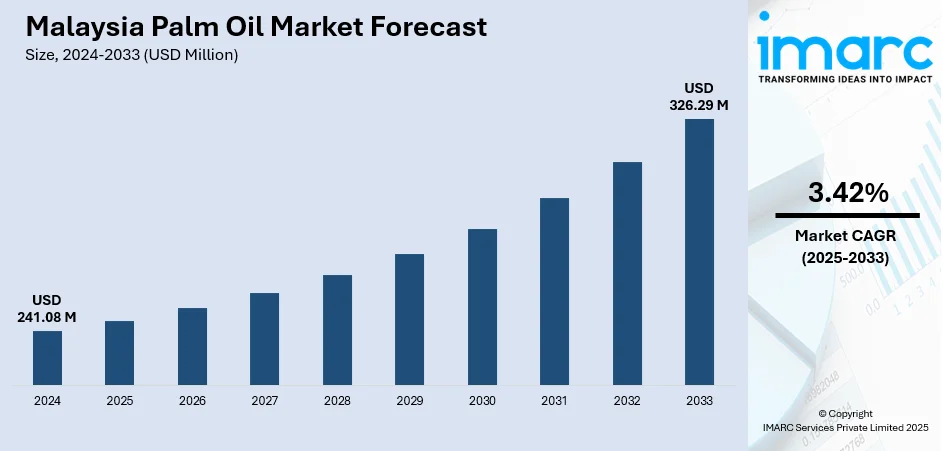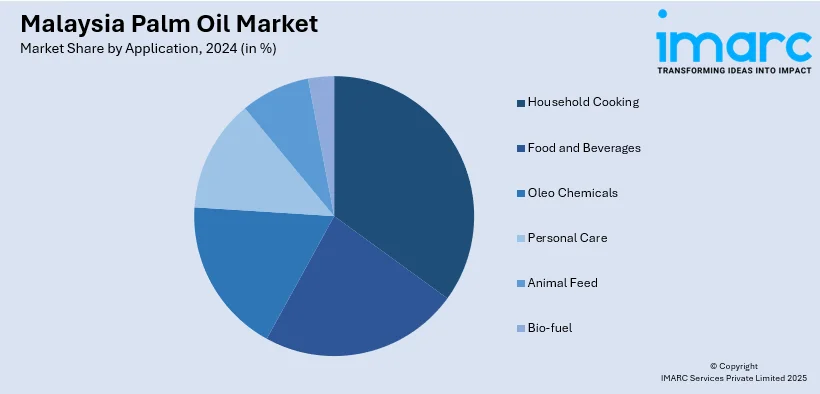
Malaysia Palm Oil Market Size, Share, Trends and Forecast by Application and States, 2025-2033
Malaysia Palm Oil Market Overview:
The Malaysia palm oil market size reached USD 241.08 Million in 2024. Looking forward, the market is expected to reach USD 326.29 Million by 2033, exhibiting a growth rate (CAGR) of 3.42% during 2025-2033. The market is fueled by consistent worldwide demand of palm oil across food, cosmetics, and biofuel sectors. The industry emphasizes sustainable practices, technological advancements in cultivation, and competitive pricing to maintain its strong export position and ensure its continued influence on the Malaysia palm oil market share.
|
Report Attribute
|
Key Statistics
|
|---|---|
|
Base Year
|
2024
|
|
Forecast Years
|
2025-2033
|
|
Historical Years
|
2019-2024
|
| Market Size in 2024 | USD 241.08 Million |
| Market Forecast in 2033 | USD 326.29 Million |
| Market Growth Rate 2025-2033 | 3.42% |
Malaysia Palm Oil Market Trends:
Strong Global Demand Across Diverse Industries
Malaysia's palm oil market is significantly driven by consistent global demand spanning food processing, personal care, pharmaceuticals, and biofuels. The high yield, long shelf life, and cost-effectiveness of the oil make it a manufacturer's choice across the world. Nations in South Asia, the Middle East, Africa, and Europe alike still import Malaysian palm oil because of its quality and consistency. Palm oil is also extensively utilized in baked foods, snack foods, instant noodles, soaps, cosmetics, and biodiesel blends. With increasing populations and urbanization, global consumption habits transform, and demand for effective, affordable oils such as palm oil does not diminish. Malaysia’s established export infrastructure and trade relationships allow it to maintain a strong position in the global supply chain, reinforcing steady Malaysia palm oil market growth.

To get more information on this market, Request Sample
Government Policies and Sustainability Initiatives
The Malaysian government plays a pivotal role in driving the palm oil market through favorable policies, export incentives, and sustainability mandates. The implementation of the Malaysian Sustainable Palm Oil (MSPO) certification ensures environmental and social governance in the supply chain, boosting global confidence and access to regulated markets. Tax incentives, replanting schemes, and research funding further strengthen the sector’s productivity and long-term viability. Regulatory bodies like MPOB (Malaysian Palm Oil Board) actively promote best practices, environmental stewardship, and technological adoption among planters and processors. As international buyers increasingly demand traceability and sustainable sourcing, Malaysia’s proactive policy framework and certification programs not only preserve market access but also enhance brand value, enabling the country to remain a top global supplier of certified sustainable palm oil.
Expansion of Downstream Processing and Value-Added Products
Malaysia is steadily shifting its palm oil industry focus from raw exports to downstream processing and higher-value product development. This includes refining, fractionation, oleochemicals, and the production of specialized palm derivatives used in food, pharmaceuticals, and cosmetics. Encouraged by government support and private investment, the expansion of downstream capabilities improves export earnings, creates jobs, and reduces dependency on fluctuating crude palm oil prices. Domestic processing allows for more control over product quality and market differentiation, meeting specialized customer requirements in global markets. Additionally, innovations in palm-based biodiesel and specialty fats are opening new avenues for growth. By enhancing vertical integration and boosting local value addition, Malaysia strengthens its competitive edge while contributing to greater market resilience and profitability.
Malaysia Palm Oil Market Segmentation:
IMARC Group provides an analysis of the key trends in each segment of the market, along with forecasts at the country and regional levels for 2025-2033. Our report has categorized the market based on application.
Application Insights:

- Household Cooking
- Food and Beverages
- Oleo Chemicals
- Personal Care
- Animal Feed
- Bio-fuel
The report has provided a detailed breakup and analysis of the market based on the application. This includes household cooking, food and beverages, oleo chemicals, personal care, animal feed, and bio-fuel.
States Insights:
- Selangor
- W.P. Kuala Lumpur
- Johor
- Sarawak
- Others
The report has also provided a comprehensive analysis of all the major states markets, which include Selangor, W.P. Kuala Lumpur, Johor, Sarawak, and others.
Competitive Landscape:
The market research report has also provided a comprehensive analysis of the competitive landscape. Competitive analysis such as market structure, key player positioning, top winning strategies, competitive dashboard, and company evaluation quadrant has been covered in the report. Also, detailed profiles of all major companies have been provided.
Malaysia Palm Oil Market News:
- In June 2025, Malaysia strengthened its global trade standing and earned broader international recognition for its sustainable palm oil by securing preferential market access under the Malaysia-European Free Trade Association (EFTA) Economic Partnership Agreement (Meepa). The agreement highlights the country’s commitment to responsible production and expands its reach in key European markets.
- In March 2025, the Oil Technologists' Association of India (OTAI) and the Malaysian Palm Oil Council (MPOC) entered a partnership to promote greater understanding of the nutritional value and health advantages of Malaysian palm oil in India. This initiative aims to strengthen sustainable trade relations between the two nations through increased awareness and cooperation.
Malaysia Palm Oil Market Report Coverage:
| Report Features | Details |
|---|---|
| Base Year of the Analysis | 2024 |
| Historical Period | 2019-2024 |
| Forecast Period | 2025-2033 |
| Units | Million USD |
| Scope of the Report |
Exploration of Historical Trends and Market Outlook, Industry Catalysts and Challenges, Segment-Wise Historical and Future Market Assessment:
|
| Applications Covered | Household Cooking, Food and Beverages, Oleo Chemicals, Personal Care, Animal Feed, Bio-fuel |
| States Covered | Selangor, W.P. Kuala Lumpur, Johor, Sarawak, Others |
| Customization Scope | 10% Free Customization |
| Post-Sale Analyst Support | 10-12 Weeks |
| Delivery Format | PDF and Excel through Email (We can also provide the editable version of the report in PPT/Word format on special request) |
Key Questions Answered in This Report:
- How has the Malaysia palm oil market performed so far and how will it perform in the coming years?
- What is the breakup of the Malaysia palm oil market on the basis of application?
- What is the breakup of the Malaysia palm oil market on the basis of states?
- What are the various stages in the value chain of the Malaysia palm oil market?
- What are the key driving factors and challenges in the Malaysia palm oil market?
- What is the structure of the Malaysia palm oil market and who are the key players?
- What is the degree of competition in the Malaysia palm oil market?
Key Benefits for Stakeholders:
- IMARC’s industry report offers a comprehensive quantitative analysis of various market segments, historical and current market trends, market forecasts, and dynamics of the Malaysia palm oil market from 2019-2033.
- The research report provides the latest information on the market drivers, challenges, and opportunities in the Malaysia palm oil market.
- Porter's five forces analysis assist stakeholders in assessing the impact of new entrants, competitive rivalry, supplier power, buyer power, and the threat of substitution. It helps stakeholders to analyze the level of competition within the Malaysia palm oil industry and its attractiveness.
- Competitive landscape allows stakeholders to understand their competitive environment and provides an insight into the current positions of key players in the market.
Need more help?
- Speak to our experienced analysts for insights on the current market scenarios.
- Include additional segments and countries to customize the report as per your requirement.
- Gain an unparalleled competitive advantage in your domain by understanding how to utilize the report and positively impacting your operations and revenue.
- For further assistance, please connect with our analysts.
 Request Customization
Request Customization
 Speak to an Analyst
Speak to an Analyst
 Request Brochure
Request Brochure
 Inquire Before Buying
Inquire Before Buying




.webp)




.webp)












